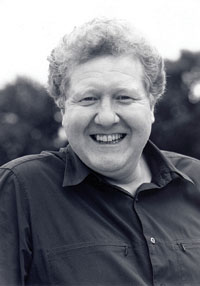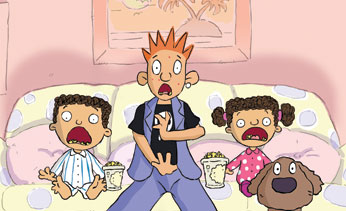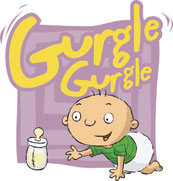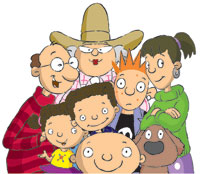Baby Aliens! Oh, My! How BB3B Series Was Realized
‘UK director, producor and writer Iain Lauchlan pushes Flash-MX to the Limit for Efficient Production’
 The success of an artist or animator is always good news for any other artist or animator. In the case of London’s Iain Lauchlan and Tell-Tale Productions, success with shows like ‘Tweenies’ and now ‘BB3B’ has included an approach to production and development that is at once highly-efficient and low-cost, while at the same time being free-wheeling, fun, and creative. By combining great ideas with great production techniques, Lauchlan’s company has found itself at the helm of animated shows that are very popular, as well as profitable. For the rest of us, there’s a great deal to be learned by looking at just how he did it.
The success of an artist or animator is always good news for any other artist or animator. In the case of London’s Iain Lauchlan and Tell-Tale Productions, success with shows like ‘Tweenies’ and now ‘BB3B’ has included an approach to production and development that is at once highly-efficient and low-cost, while at the same time being free-wheeling, fun, and creative. By combining great ideas with great production techniques, Lauchlan’s company has found itself at the helm of animated shows that are very popular, as well as profitable. For the rest of us, there’s a great deal to be learned by looking at just how he did it.
Lauchlan, age 53, works with writing partner Will Brenton in Tell-Tale’s London offices. Their big hit show is ‘Tweenies’, now six years on at the BBC and in 60 countries around the world. That’s 390 20-minute shows, two sell-through videos, various TV specials like ‘Tweenies Talk of the Pops’ and numerous live-arena stage shows to audiences of as many as 4,000 people or more.
“It’s the biggest export the BBC has ever had,” Lauchlan said. “It’s still the number one program in the UK.”
So with nowhere to go but up, Lauchlan and a company called Entertainment Rights Plc have recently rolled out ‘BB3B’, a 2-D kid’s show with an unusual premise. What may be as unique as the story material and premise of ‘BB3B’ is the fact that this 20-minute broadcast quality program for TV is created entirely with Flash-MX software, which is widely available, inexpensive, and simple to master.
“We’ve pushed Flash animation as far as it could go, to the absolute limit,” said Lauchlan. “It’s worked out really well.”
How does a show like ‘BB3B’ go from point A to point B? The series went on the air at BBC in early January of 2005, and is shown twice a week. Lauchlan said they typically get more than a million UK viewers with each broadcast, and with only 13 episodes completed, BBC is asking for more. The show is also headed to French TV this summer, and will likely follow the same distribution path to U.S. markets (and globally) as ‘Tweenies’ did.
Lauchlan said that ‘BB3B’ has been three years in development and production. The seed for this idea was a concept from writer Will Brenton. The show’s basic premise centers around a pair of young American twins, a girl and a boy, who watch old ‘B-movie’ science fiction films with their baby-sitter, and when a new baby enters the household, the twins erroneously conclude the infant is an alien. The theme is sibling rivalry, set against an amusing kid’s view of old sci-fi films, aliens, and a lot of baby stuff. The title, ‘BB3B’, stands for Billy Bob 3rd Baby. More on the story elements in a moment….
So, with a little preliminary work, Brenton and Lauchlan took ‘BB3B’ and two other projects to the Cartoon Forum Expo in Germany a number of years ago, their first time at this event.
“We sold all three,” Lauchlan said.Funding production, of course, was the first hurdle in the process. Even using the inexpensive Flash-MX animation software, the budget for ‘BB3B’ would be £2 million British pounds. “What we had to do, once we had our broadcaster’s money, was to find distributors who would distribute it around the world,” Lauchlan said.
 BBC would put up 25 percent of the money from their children’s programming fund. Other money would come from licensing. “It’s like a jig-saw, getting it all together,” Lauchlan said.
BBC would put up 25 percent of the money from their children’s programming fund. Other money would come from licensing. “It’s like a jig-saw, getting it all together,” Lauchlan said.
Artists and animators in studios in Manchester, Cardiff, Bristol and Malaysia began work, including freelancers. As many as 30 people were part of the creative team. Lauchlan said he usually works on Mac computers, but ‘BB3B’ would be done on PCs.
But the starting point was still the story, and consequently scripts. ‘BB3B’ as a story premise seems positive, healthy for kids, lots of fun, silly, and maybe a little spooky and provocative. The theme of sibling-rivalry, with the send-up of old ‘Bmovie’ sci-fi films, and the humor inherent in two six-year old kids who feel their new baby brother may be an alien from another planet, provides a mix of elements that is ripe for interesting stories and insights.
“I thought it would appeal to children, because we were choosing a subject they would recognize,” said Lauchlan. “The theme is ‘invading your space’. We wanted twins so it was not boy-skewed or girl-skewed.”
When Billy Bob (the baby) comes in, he takes over’ the parents, with an ‘alien’ language (baby-talk), and strange things like baby-smells, diapers, baby-food, and so on. “They (the twins) just thought they were invaded by this alien who arrived one day,” Lauchlan said.
As the twins are cared for by their teenage babysitter, they end up watching a lot of ‘B-movie’ science fiction films on TV, with all the rocketships, monsters, extra-terrestrials, laboratories, and so on, that goes with them.
“It’s all a misconception from their point of view, and that’s what gives us the comedy,” Lauchlan said.
For each episode, the writers could take their starting point from some well-known or classic sci-fi film from the past. Some of these that have been completed include episodes such as ‘Starship Poopers’ (in which the twins discover that their alien brother is controlling people with baby-smells from his nappy), or ‘BB Phone Home’ (in which the twins discover that Billy Bob is communicating with fellow ‘sprogs’ in outer space via his baby monitor), or ‘From Here to Maternity’ (the twins discover an alien breeding farm at the local hospital).
Lauchlan pointed out that despite the various adventures of the twins, Baby Billy Bob is never in any danger whatsoever, and is always completely happy and well cared-for. “It was Will who created it,” said Lauchlan. “We always start with a reason for being. We wanted to do something about sibling rivalry, looking to see the comedy in it. The B-movie thing was very important, as was the alien stuff.”
As many as eight freelance writers were brought in to begin scripting the 22-minute episodes, including two writers from the U.S. This group was eventually pared down to just four writers. Scripts were then written, with Lauchlan doing the final edit.
 “It was quite tough at the beginning to get the style of humor right,” he said. He added that his company made an extra effort to pay writers a decent rate for their work, which came to about 6,000 British pounds per script. “It’s a real battle for us,” he said. “We try to get the pay scale up for the writer.”
“It was quite tough at the beginning to get the style of humor right,” he said. He added that his company made an extra effort to pay writers a decent rate for their work, which came to about 6,000 British pounds per script. “It’s a real battle for us,” he said. “We try to get the pay scale up for the writer.”
The family in the story is American, and Lauchlan is hopeful the program can be launched on American cable networks for U.S. audiences. “We wanted to try to take a leaf from the American book,” he said. “We very much would like to try to get it into America.”
Voice-actors for the show’s characters did not include any well-known celebrities, but instead were provided by what Lauchlan called ‘jobbing actors’. He added that he was pleased with the fact that the audio-track was recorded in ‘real time’ like a radio-play, prior or concurrent to the animation, lending a fluid or realistic quality to the performances. “We did it like a play,” he said.
Lauchlan served as the director for this aspect, as well as the animation. “The whole process took us about 20 months,” he said. “It was really quite tricky.” Using the latest version of Flash-MX and “pushing it to the absolute limits”, Lauchlan’s team of 30 artists in different locations were set to work providing the ‘pipeline’ of material that would be ready for broadcast. Story meetings were held, and scripts were prepared. Thumb-nail images were created to lay out the flow of the action, which then became a complete storyboard.
The story-board is then rendered in Flashas a very simple ‘animatic’, which is the basis of the rest of the more detailed animation. At this point the sound-track is created (as above), and the scenes are timed out. Bit-by-bit, each episode is created in a systematic way, for greatest efficiency.
 Character design was done by American artist Mike Gordon, an illustrator originally from London. Another great aspect of the project, as far as Lauchlan is concerned, is the ‘very interesting’ music provided by a band called ‘Bis’. Lauchlan said Bis is a hit band in Japan, and consists of a girl and two boys, now living in Glasgow. Bis did the title sequence music, and actually recorded a brand new original tune for each episode, which is included in the action. Lauchlan said that in part because of the popularity of Bis’ music, the band actually appears in the series as animated versions of themselves.
Character design was done by American artist Mike Gordon, an illustrator originally from London. Another great aspect of the project, as far as Lauchlan is concerned, is the ‘very interesting’ music provided by a band called ‘Bis’. Lauchlan said Bis is a hit band in Japan, and consists of a girl and two boys, now living in Glasgow. Bis did the title sequence music, and actually recorded a brand new original tune for each episode, which is included in the action. Lauchlan said that in part because of the popularity of Bis’ music, the band actually appears in the series as animated versions of themselves.
The original 13 episodes ended up costing 2-million British pounds to make. The greatest cost, Lauchlan said, is paying highly-qualified European animators for the hours and hours of work needed to create the show. “It’s the animator’s time,” he said. “Not only that, but when you’re farming out to four or five different studios, you get returns. You get it back, and it’s just not right.”
Only a fraction of the animation was done in Malaysia. Lauchlan said he is sensitive to the fact that European animators resist ‘farming out’ work to cheaper labor pools in Third-World nations such as Malaysia, but that as the project progressed he found that it was simply a production solution he could not avoid.
“We desperately wanted to make all of it in the UK,” he said. “But we were up against it, time-wise. Because they are so involved, these episodes. I don’t mind doing this as long as some of it is done in the U.K.”
The company he worked with in Malaysia is called Fat Lizard, and he said he was pleased with their performance.
Images © 2004 Tell-Tale Productions Limited 2005, a wholly owned subsidiary of Entertainment Rights Plc. All rights reserved.

